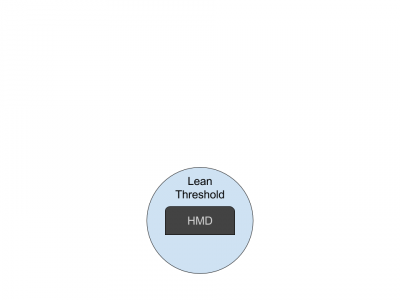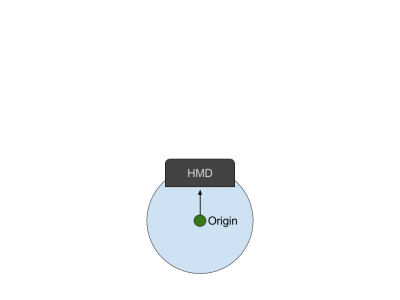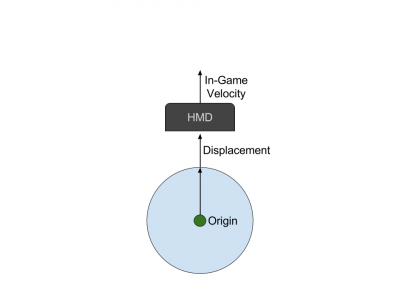Lean-To-Move
| Lean-To-Move | |
|---|---|
| Information | |
| Type | Standing, Room-scale |
| Required Devices | Motion-tracked controllers |
| Description | Press a trigger on controller to record your origin, lean beyond the boundary threshold to move in game, return to origin to stop |
| Pros | Mitigates VR sickness, frees up the hands while moving, move for longer without being fatigued |
| Cons | ??? |
| Creator | https://github.com/Erupac/LeanToMove |
Additional Information
The mechanics of Lean-to-Move are simple. The player initiates the movement by pressing the trigger. The system then stores the location of the head when the trigger was pressed as the origin of movement.
Next, the system waits for the player to lean or move outside of the threshold region. Once the player breaches this radius, the distance between the head and the wall of the threshold is used to compute the player’s velocity.
Steps
 When the player initializes Lean-to-Move, the HMD's original position is saved.
When the player initializes Lean-to-Move, the HMD's original position is saved.
 As the player leans away from the origin, the distance from the origin to the HMD is calculated. If the distance is less than the lean threshold, then no movement is created.
As the player leans away from the origin, the distance from the origin to the HMD is calculated. If the distance is less than the lean threshold, then no movement is created.
 As the HMD goes past the lean threshold, the displacement from the lean threshold boundary to the HMD is used as the velocity vector in the game. The further the HMD from the boundary, the faster the player goes. Returning the HMD to the origin brings the player to a full stop.
As the HMD goes past the lean threshold, the displacement from the lean threshold boundary to the HMD is used as the velocity vector in the game. The further the HMD from the boundary, the faster the player goes. Returning the HMD to the origin brings the player to a full stop.
Advantages
Lean-to-Move helps to mitigate nausea in a similar way to other locomotion strategies being deployed today. One major advantage of Lean-to-Move is that it frees up the player’s hands to be able to do whatever the game requires. In the FPS setting, for instance, a player can more naturally wield their weapon while moving around. Lean-to-Move also has a low activity overhead, meaning that players can use it for longer without experiencing fatigue.